Blog & Latest Updates
Fly Fishing Articles
Insects by Common Name


Arthropod Class Insecta (Insects)
Taxonomic Navigation -?-
1 order isn't included.
Common Name
| Match | Common Name |
| Insects |
This is page 83 of specimens of Insecta. Visit the main Insecta page for:
- The behavior and habitat of Insecta.
- 114 underwater pictures of Insecta.
Pictures of 1229 Insect Specimens:
Hesperoperla pacifica (Golden Stone) Stonefly Nymph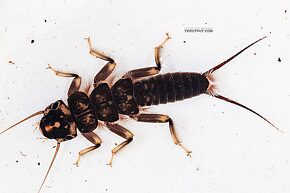 View 9 PicturesID notes from the microscope: The occiput (Occiput: The back of the head.) has a sinuate, irregularly spaced spinule row.
View 9 PicturesID notes from the microscope: The occiput (Occiput: The back of the head.) has a sinuate, irregularly spaced spinule row.
 View 9 PicturesID notes from the microscope: The occiput (Occiput: The back of the head.) has a sinuate, irregularly spaced spinule row.
View 9 PicturesID notes from the microscope: The occiput (Occiput: The back of the head.) has a sinuate, irregularly spaced spinule row.Collected August 3, 2020 from the East Fork Big Lost River in Idaho
Added to Troutnut.com by Troutnut on August 19, 2020
Added to Troutnut.com by Troutnut on August 19, 2020
Ephemerella aurivillii Mayfly Nymph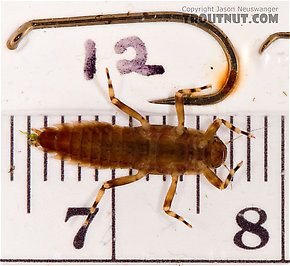 View 9 PicturesI'm pretty sure this is Ephemerella aurivillii. The body is 11mm long, which rules out most other species, and the hind legs seem to be more than 1.5 times longer than the fore legs -- a key characteristic for this species.
View 9 PicturesI'm pretty sure this is Ephemerella aurivillii. The body is 11mm long, which rules out most other species, and the hind legs seem to be more than 1.5 times longer than the fore legs -- a key characteristic for this species.
This specimen isn't in the best of shape, as it's missing all three tails, but it's the only one of its species I captured in this sample.
 View 9 PicturesI'm pretty sure this is Ephemerella aurivillii. The body is 11mm long, which rules out most other species, and the hind legs seem to be more than 1.5 times longer than the fore legs -- a key characteristic for this species.
View 9 PicturesI'm pretty sure this is Ephemerella aurivillii. The body is 11mm long, which rules out most other species, and the hind legs seem to be more than 1.5 times longer than the fore legs -- a key characteristic for this species.This specimen isn't in the best of shape, as it's missing all three tails, but it's the only one of its species I captured in this sample.
Collected May 6, 2007 from Mongaup Creek in New York
Added to Troutnut.com by Troutnut on May 18, 2007
Added to Troutnut.com by Troutnut on May 18, 2007
Male Ephemerella excrucians (Pale Morning Dun) Mayfly Spinner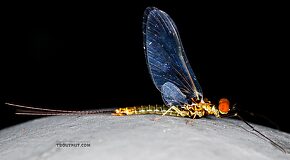 View 4 Pictures
View 4 Pictures
 View 4 Pictures
View 4 PicturesCollected August 1, 2020 from the Henry's Fork of the Snake River in Idaho
Added to Troutnut.com by Troutnut on August 18, 2020
Added to Troutnut.com by Troutnut on August 18, 2020
Male Maccaffertium terminatum Mayfly Spinner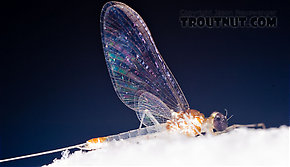 View 11 PicturesI positively identified this specimen under a microscope with a good key. It was one of the more common species in a generally light mixed bag of mayflies over a big Catskill tailwater last night.
View 11 PicturesI positively identified this specimen under a microscope with a good key. It was one of the more common species in a generally light mixed bag of mayflies over a big Catskill tailwater last night.
I swooped this one out of the air while it was mating with a female, so I can be certain about her ID as well.
 View 11 PicturesI positively identified this specimen under a microscope with a good key. It was one of the more common species in a generally light mixed bag of mayflies over a big Catskill tailwater last night.
View 11 PicturesI positively identified this specimen under a microscope with a good key. It was one of the more common species in a generally light mixed bag of mayflies over a big Catskill tailwater last night.I swooped this one out of the air while it was mating with a female, so I can be certain about her ID as well.
Collected June 7, 2007 from the West Branch of the Delaware River in New York
Added to Troutnut.com by Troutnut on June 8, 2007
Added to Troutnut.com by Troutnut on June 8, 2007
Female Grammotaulius lorettae (Northern Caddisfly) Caddisfly Adult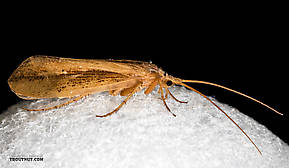 View 8 Pictures
View 8 Pictures
 View 8 Pictures
View 8 PicturesCollected August 11, 2018 from the Henry's Fork of the Snake River in Idaho
Added to Troutnut.com by Troutnut on June 12, 2019
Added to Troutnut.com by Troutnut on June 12, 2019
Timpanoga hecuba (Great Red Quill) Mayfly Nymph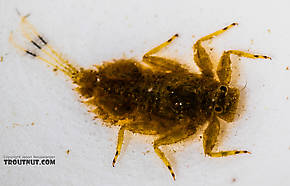 View 6 Pictures
View 6 Pictures
 View 6 Pictures
View 6 PicturesCollected August 31, 2018 from the Bitterroot River in Montana
Added to Troutnut.com by Troutnut on June 13, 2019
Added to Troutnut.com by Troutnut on June 13, 2019
Heptagenia pulla (Golden Dun) Mayfly Nymph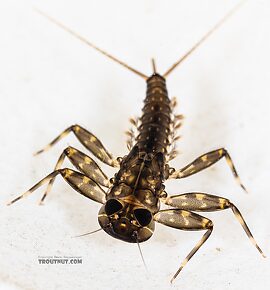 View 11 PicturesThis specimen is interesting because Heptagenia pulla has not been reported from Washington or neighboring states (Saskatchewan is the closest), yet the distinctive key characteristics are clear.
View 11 PicturesThis specimen is interesting because Heptagenia pulla has not been reported from Washington or neighboring states (Saskatchewan is the closest), yet the distinctive key characteristics are clear.
It keys to the genus Heptagenia because the tarsal claw (Tarsal claw: The claws at the tip of the tarsus, on an insect's "foot.") has a single basal (Basal: close to the base; root or beginning) tooth, and the gills on segment 7 have fibrils.
For the species key:
1. The left mandible (Mandible: The paired jaws of an insect which are used for grabbing food, located immediately behind the labrum.) is planate (fairly straight-edged) whereas the right mandible (Mandible: The paired jaws of an insect which are used for grabbing food, located immediately behind the labrum.) is angulate (has one sharp turn on the edge).
2. The labrum (Labrum: The platelike structure forming the roof of the mouth of insects; the upper lip.) is much wider than long.
3. There's a thin light-colored streak lateral (Lateral: To the side.) to the eye on the head.
 View 11 PicturesThis specimen is interesting because Heptagenia pulla has not been reported from Washington or neighboring states (Saskatchewan is the closest), yet the distinctive key characteristics are clear.
View 11 PicturesThis specimen is interesting because Heptagenia pulla has not been reported from Washington or neighboring states (Saskatchewan is the closest), yet the distinctive key characteristics are clear.It keys to the genus Heptagenia because the tarsal claw (Tarsal claw: The claws at the tip of the tarsus, on an insect's "foot.") has a single basal (Basal: close to the base; root or beginning) tooth, and the gills on segment 7 have fibrils.
For the species key:
1. The left mandible (Mandible: The paired jaws of an insect which are used for grabbing food, located immediately behind the labrum.) is planate (fairly straight-edged) whereas the right mandible (Mandible: The paired jaws of an insect which are used for grabbing food, located immediately behind the labrum.) is angulate (has one sharp turn on the edge).
2. The labrum (Labrum: The platelike structure forming the roof of the mouth of insects; the upper lip.) is much wider than long.
3. There's a thin light-colored streak lateral (Lateral: To the side.) to the eye on the head.
Collected April 9, 2021 from the Yakima River in Washington
Added to Troutnut.com by Troutnut on April 12, 2021
Added to Troutnut.com by Troutnut on April 12, 2021
Female Ephemerella invaria (Sulphur Dun) Mayfly Dun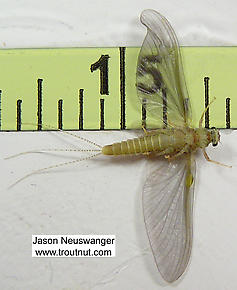 View 2 Pictures
View 2 Pictures
 View 2 Pictures
View 2 PicturesCollected May 23, 2004 from unknown in Wisconsin
Added to Troutnut.com by Troutnut on January 25, 2006
Added to Troutnut.com by Troutnut on January 25, 2006
Maccaffertium (March Browns and Cahills) Mayfly Nymph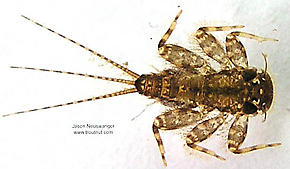 View 4 Pictures
View 4 Pictures
 View 4 Pictures
View 4 PicturesCollected January 12, 2004 from unknown in Wisconsin
Added to Troutnut.com by Troutnut on January 25, 2006
Added to Troutnut.com by Troutnut on January 25, 2006
Male Baetis bicaudatus (BWO) Mayfly Nymph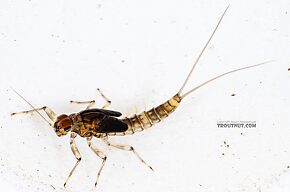 View 7 PicturesThis specimen was collected along with a female which was quite a bit larger, different in color, but otherwise seemed the same morphologically.
View 7 PicturesThis specimen was collected along with a female which was quite a bit larger, different in color, but otherwise seemed the same morphologically.
 View 7 PicturesThis specimen was collected along with a female which was quite a bit larger, different in color, but otherwise seemed the same morphologically.
View 7 PicturesThis specimen was collected along with a female which was quite a bit larger, different in color, but otherwise seemed the same morphologically.Collected April 12, 2021 from Holder Creek in Washington
Added to Troutnut.com by Troutnut on April 13, 2021
Added to Troutnut.com by Troutnut on April 13, 2021
Top 10 Fly Hatches
Top Gift Shop Designs
Eat mayflies.
Top Insect Specimens
Miscellaneous Sites
Troutnut.com is copyright © 2004-2024 Jason
Neuswanger (email Jason). See my FAQ for information about use of my images.
 privacy policy
privacy policy
